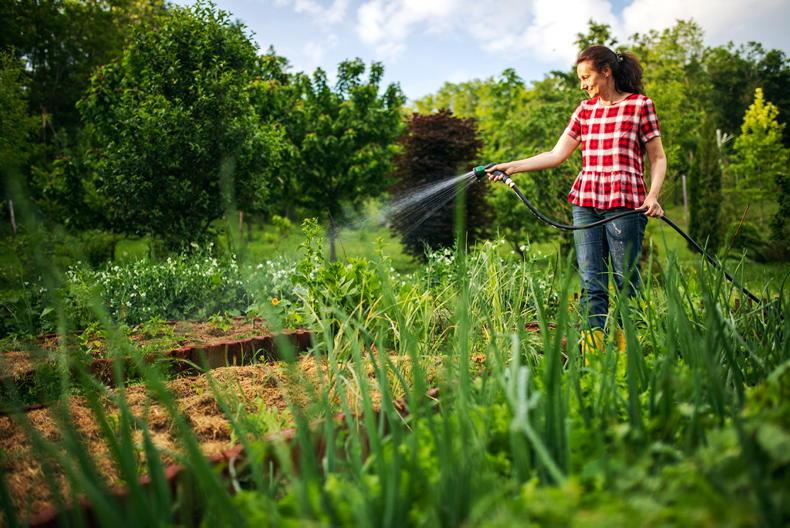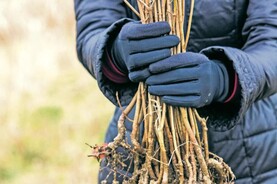High summer is here and your kitchen garden should be bursting with growth and providing plenty of pickings. With this in mind, there is a need for continued crop care, and lots of glorious sunshine with enough rain at night to keep things growing.
Not much to ask for really.
Carrot Care
Carrots sown last month will need attention in the establishment stage. Keeping beds weed free and moist is a must. Liquid seaweed will encourage healthy growth and mulching between rows with compost will add nutrients, conserve moisture and help prevent weed growth.
Thinning requirements will depend on germination success but if, and when necessary, water the bed first and thin seedlings to 3-4cm spacing and weeding as you work. Water again after thinning and remember tiny carrots make delicious snacks and tender tops can be used to make pesto.
When lifting the Bionet crop cover for maintenance, do so on a windy day, early in the morning or late in the evening, getting in and out as swiftly as possible. It is known that the carrot root fly is attracted by scent so never leave thinnings or damaged foliage lying on the ground.
Carrots have a tendency to push their tops out of the ground as they mature, so make sure to earth up occasionally to avoid green shoulders.
Tending your Tomatoes
To keep tomato plants healthy and productive, gentle intervention is required.
If growing Cordon (indeterminate) varieties, remember to continually tie-in plants to existing support cane or string and regularly ‘side-shoot’. This is the process of pinching out the small shoots that grow in the space between the main stem and the leaf, known as the leaf axil. Removing the side-shoots means that you maintain a single vine per plant which is much easier to manage, and the plant can concentrate on putting its energy into fruit production.

Side-shooting tomatoes in a greenhouse. \ iStock
It’s also good to remove the bottom leaves of the plants up to the first truss (bunch of fruit) as this allows better air-flow around the base of the plants and helps sunlight penetrate to the fruit to ripen them.
Bush (determinate) varieties do not require side-shooting but will need some support as fruits set and weigh the plant down. Depending on varieties and date sown, the first tomatoes should be ripe and ready for picking in the coming weeks.
Water, Water, Water
Irish weather is unpredictable but in dry spells, plants – especially those growing in containers – need to be checked at least twice a day. The general rule is to water in the morning, gently and thoroughly rather than little and often. When watering in the evening, ensure there is enough time for the plant leaves to dry and be warned, slugs are predominantly creatures of the night and love wet ground. A good soaking encourages plants to put down deep roots and find the water they need.
The ‘water the soil, not the plant’ mantra is important to remember as water is taken in by the roots and evaporated by the leaves.
Water can be delivered to plants in many ways ranging from basic watering cans, hoses to high-tech irrigation systems. Hand held hoses are handy but be careful not to damage plants whilst dragging them around the garden. The best way to avoid this is by installing guides at the end of each bed. These can be metal or wood.

Watering the vegetable garden. \ iStock
Weeding, Feeding and Mulching
No-dig amounts to less weeds and at this time of year, plants are in full growth with leaves beginning to form a canopy, keeping weed seed germination in check. But paths and some beds will require weeding and it pays to catch them early by running a hoe over the bed on a dry day, leaving uprooted weed seedlings on the ground to wither in the sun.
Crops will thrive if given an additional nutrient pick-me-up at this point of peak growth. Liquid feeds are ideal for the job as they are easily absorbed by plants. The comfrey, nettle and seaweed feeds made back in May are now ready to use and plants will benefit from a feed every 10 to 14 days.
Be warned that these feeds are concentrated and must be diluted. The first two are highly odoriferous so I wouldn’t recommend using them on indoor or patio plants before a summer gathering.
The rule of thumb is to use 10 parts water to one part liquid feed with the diluted mix having the colour of weak tea. Apply feeds to the soil early in the morning or late in the afternoon.
Nettles – being rich in nitrogen and silica – will boost all plants but is particularly effective on leafy greens such as cabbage, kale, chard, spinach, etc. Comfrey is rich in potassium and will aid fruit set in flowering plants, so your tomatoes, courgettes, squash, sweet peas will be glad of a sup. Seaweed is a great all-rounder providing lots of trace elements so as a rule, I add it to all my feeds.
Organic mulches such as compost, seaweed, grass clippings, leaf mould, wilted comfrey leaves and straw are your ally at this time of year. Not only will they help conserve moisture and stablise soil temperatures but they will add additional nutrients to the soil. It is vital to water/feed before you mulch if the ground is dry.
The ‘Second Spring’
It may seem counter-intuitive to start thinking about the colder months since the warm season has just begun, but now is the time to start planning and sowing if you want to keep your plot productive. This second half of the summer is often referred to as the ‘Second Spring’ as a variety of crops can be sown in July such as; beetroot, carrot, chard, chicory, Dwarf French beans, Florence fennel, kale, kohlrabi, lettuce, Oriental salads, rocket, spinach, spring onions, turnips, and winter lettuce.
High summer is here and your kitchen garden should be bursting with growth and providing plenty of pickings. With this in mind, there is a need for continued crop care, and lots of glorious sunshine with enough rain at night to keep things growing.
Not much to ask for really.
Carrot Care
Carrots sown last month will need attention in the establishment stage. Keeping beds weed free and moist is a must. Liquid seaweed will encourage healthy growth and mulching between rows with compost will add nutrients, conserve moisture and help prevent weed growth.
Thinning requirements will depend on germination success but if, and when necessary, water the bed first and thin seedlings to 3-4cm spacing and weeding as you work. Water again after thinning and remember tiny carrots make delicious snacks and tender tops can be used to make pesto.
When lifting the Bionet crop cover for maintenance, do so on a windy day, early in the morning or late in the evening, getting in and out as swiftly as possible. It is known that the carrot root fly is attracted by scent so never leave thinnings or damaged foliage lying on the ground.
Carrots have a tendency to push their tops out of the ground as they mature, so make sure to earth up occasionally to avoid green shoulders.
Tending your Tomatoes
To keep tomato plants healthy and productive, gentle intervention is required.
If growing Cordon (indeterminate) varieties, remember to continually tie-in plants to existing support cane or string and regularly ‘side-shoot’. This is the process of pinching out the small shoots that grow in the space between the main stem and the leaf, known as the leaf axil. Removing the side-shoots means that you maintain a single vine per plant which is much easier to manage, and the plant can concentrate on putting its energy into fruit production.

Side-shooting tomatoes in a greenhouse. \ iStock
It’s also good to remove the bottom leaves of the plants up to the first truss (bunch of fruit) as this allows better air-flow around the base of the plants and helps sunlight penetrate to the fruit to ripen them.
Bush (determinate) varieties do not require side-shooting but will need some support as fruits set and weigh the plant down. Depending on varieties and date sown, the first tomatoes should be ripe and ready for picking in the coming weeks.
Water, Water, Water
Irish weather is unpredictable but in dry spells, plants – especially those growing in containers – need to be checked at least twice a day. The general rule is to water in the morning, gently and thoroughly rather than little and often. When watering in the evening, ensure there is enough time for the plant leaves to dry and be warned, slugs are predominantly creatures of the night and love wet ground. A good soaking encourages plants to put down deep roots and find the water they need.
The ‘water the soil, not the plant’ mantra is important to remember as water is taken in by the roots and evaporated by the leaves.
Water can be delivered to plants in many ways ranging from basic watering cans, hoses to high-tech irrigation systems. Hand held hoses are handy but be careful not to damage plants whilst dragging them around the garden. The best way to avoid this is by installing guides at the end of each bed. These can be metal or wood.

Watering the vegetable garden. \ iStock
Weeding, Feeding and Mulching
No-dig amounts to less weeds and at this time of year, plants are in full growth with leaves beginning to form a canopy, keeping weed seed germination in check. But paths and some beds will require weeding and it pays to catch them early by running a hoe over the bed on a dry day, leaving uprooted weed seedlings on the ground to wither in the sun.
Crops will thrive if given an additional nutrient pick-me-up at this point of peak growth. Liquid feeds are ideal for the job as they are easily absorbed by plants. The comfrey, nettle and seaweed feeds made back in May are now ready to use and plants will benefit from a feed every 10 to 14 days.
Be warned that these feeds are concentrated and must be diluted. The first two are highly odoriferous so I wouldn’t recommend using them on indoor or patio plants before a summer gathering.
The rule of thumb is to use 10 parts water to one part liquid feed with the diluted mix having the colour of weak tea. Apply feeds to the soil early in the morning or late in the afternoon.
Nettles – being rich in nitrogen and silica – will boost all plants but is particularly effective on leafy greens such as cabbage, kale, chard, spinach, etc. Comfrey is rich in potassium and will aid fruit set in flowering plants, so your tomatoes, courgettes, squash, sweet peas will be glad of a sup. Seaweed is a great all-rounder providing lots of trace elements so as a rule, I add it to all my feeds.
Organic mulches such as compost, seaweed, grass clippings, leaf mould, wilted comfrey leaves and straw are your ally at this time of year. Not only will they help conserve moisture and stablise soil temperatures but they will add additional nutrients to the soil. It is vital to water/feed before you mulch if the ground is dry.
The ‘Second Spring’
It may seem counter-intuitive to start thinking about the colder months since the warm season has just begun, but now is the time to start planning and sowing if you want to keep your plot productive. This second half of the summer is often referred to as the ‘Second Spring’ as a variety of crops can be sown in July such as; beetroot, carrot, chard, chicory, Dwarf French beans, Florence fennel, kale, kohlrabi, lettuce, Oriental salads, rocket, spinach, spring onions, turnips, and winter lettuce.








 This is a subscriber-only article
This is a subscriber-only article









SHARING OPTIONS: